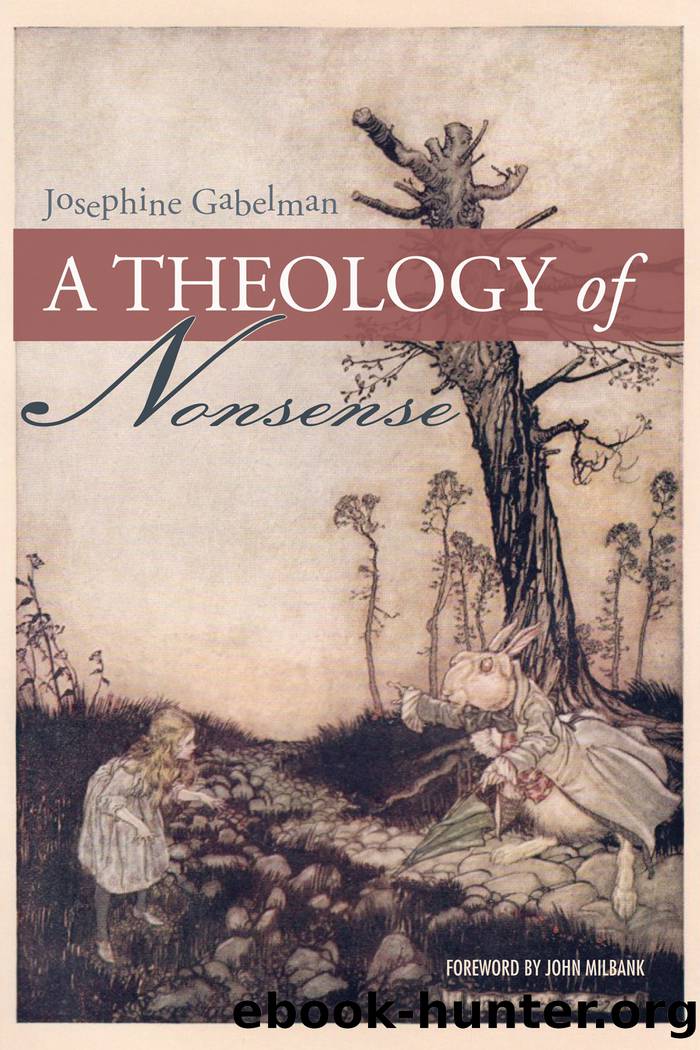A Theology of Nonsense by Gabelman Josephine;Milbank John;

Author:Gabelman, Josephine;Milbank, John; [Gabelman, Josephine]
Language: eng
Format: epub
Tags: Religion, General
ISBN: 9781532601897
Publisher: Wipf and Stock Publishers
Published: 2016-09-08T07:00:00+00:00
Constructive Disturbance
Behold the kingdom of God is in the midst of you
Luke 17:21
When we think of political anarchy, we tend to imagine an ideology that breaks, defies, or deconstructs, and would not normally perhaps conceive of a restorative or reconstructive dimension to anarchy. While it is clear that the type of sociopolitical disturbance discussed above is indeed a vital anarchic component, Berdyaev advances the idea that Christian anarchy also transforms and restores the world it has deconstructed. âThe new aeon,â he observes, âdoes not simply belong to the other world, to the other side of the grave, it is not something entirely different. It is also our world enlightened and transfigured and which has become creatively free.â440 Although this might appear to be an unlikely aspect of anarchy, Marshall has indicated that anarchy is not simply the moment of defiance, but the ongoing âcondition of a people living.â Anarchy does break, but for Berdyaev it is in order to rebuild; it is defiant, but so that it can reclaim; it intentionally unsettles, but always with the desire to transform.
This process of disturbing in order to recreate has something in common with Tolkienâs description of fairy-tales, which he believes follows the pattern of âescape, recovery and consolation.â441 In her essay, âApologetics and the Imagination: Making Strangeâ Alison Milbank discusses the first two aspects of Tolkienâs three-fold definition, explaining: âEscape speaks to our desire to burst the limits of our ordinary experience. [. . .] The second function, recovery, returns us to our own world but seen in a new way.â442 This pattern of disturbing the ordinary in order to accomplish its creative re-vision, as we will see, is a close echo of Berdyaevâs account of Christian anarchy, which, having âburst the limitsâ of the conventional, then seeks to restore and reveal the holy within the everyday.
Tolkienâs modelâin particular the aspect of recoveryâcan also help to convey the effect of the end of the Alice stories upon the readerâs imagination. We have discussed how the Alice narratives both culminate in revolt. Without wanting to undercut this violent climax it would be misleading to leave the discussion there, since in neither book is the end of Aliceâs adventures the close of the story. The aim of recovery, Tolkien concludes, is to free the mundane âfrom the drab blur of triteness or familiarity.â443 In a similar way, Carroll closes both stories by appealing to dream and memory, which, as before, disturbs the world of sense, but this time in order to awaken an appreciation of the marvelous within the commonplace, rather than simply overturning or undermining its governing principles. We might allude to Coleridgeâs description of Wordsworthâs poetry as representative of literatureâs transformative potential, and endeavor to find out if Carrollâs nonsense has the same ability: âto give the charm of novelty to things of every day, and to excite a feeling analogous to the supernatural.â444
In the first book, Alice wakes from the dream-world and relays the dream to her sister. This affects the sisterâs experience of the real world, which becomes oddly enchanted by Aliceâs tale.
Download
This site does not store any files on its server. We only index and link to content provided by other sites. Please contact the content providers to delete copyright contents if any and email us, we'll remove relevant links or contents immediately.
Killing Kryptonite: Destroy What Steals Your Strength by John Bevere(46)
Vertical Church by James MacDonald(38)
Free Will Revisited by Picirilli Robert E.;(27)
The Post-Evangelical by Dave Tomlinson(24)
You Lost Me Discussion Guide by David Kinnaman(22)
The Navigator by Issue 29-Focus-on-Pilots(20)
Godâs Shining Forth by Hay Andrew R.;Davidson Ivor J.;(18)
A Theology of Nonsense by Gabelman Josephine;Milbank John;(16)
CHRISTIAN PERFECTION by Unknown(9)
Mystic Treatises by Isaac of Nineveh by A.J. Wensinck(8)
